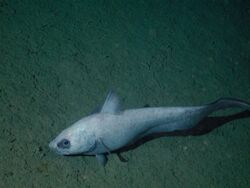Biology:Coryphaenoides
From HandWiki
Short description: Genus of fishes
| Coryphaenoides | |
|---|---|

| |
| Coryphaenoides acrolepis | |

| |
| Coryphaenoides leptolepis | |
| Scientific classification | |
| Domain: | Eukaryota |
| Kingdom: | Animalia |
| Phylum: | Chordata |
| Class: | Actinopterygii |
| Order: | Gadiformes |
| Family: | Macrouridae |
| Subfamily: | Macrourinae |
| Genus: | Coryphaenoides Gunnerus, 1765 |
| Type species | |
| Coryphaenoides rupestris Gunnerus, 1765
| |
| Synonyms[2] | |
| |
Coryphaenoides is a genus of rattails which is found in all oceans of the world.[3] They are found in deep waters and C. yaquinae, recorded to 7,012 m (23,005 ft), is the only member in the family known from the hadal zone.[4]
The generic name means "similar to Coryphaena".[5]
Species
File:Autonomous landers, Observing the deepest places on Earth.WebM There are currently 66 recognized species in this genus:
- Coryphaenoides acrolepis (T. H. Bean, 1884) (Pacific grenadier)
- Coryphaenoides affinis Günther, 1878
- Coryphaenoides alateralis N. B. Marshall & Iwamoto, 1973
- Coryphaenoides altipennis Günther, 1877
- Coryphaenoides anguliceps (Garman, 1899) (Loose-scale grenadier)
- Coryphaenoides ariommus C. H. Gilbert & W. F. Thompson, 1916 (Humboldt grenadier)
- Coryphaenoides armatus (J. Hector, 1875) (Abyssal grenadier)
- Coryphaenoides asper Günther, 1877
- Coryphaenoides asprellus (H. M. Smith & Radcliffe, 1912)
- Coryphaenoides boops (Garman, 1899) (Short-snout grenadier)
- Coryphaenoides brevibarbis (Goode & T. H. Bean, 1896) (Short-beard grenadier)
- Coryphaenoides bucephalus (Garman, 1899) (Narrow-snout grenadier)
- Coryphaenoides bulbiceps (Garman, 1899) (Large-eye grenadier)
- Coryphaenoides camurus (H. M. Smith & Radcliffe, 1912)
- Coryphaenoides capito (Garman, 1899) (Big-head grenadier)
- Coryphaenoides carapinus Goode & T. H. Bean, 1883 (Carapine grenadier)
- Coryphaenoides carminifer (Garman, 1899) (Carmine grenadier)
- Coryphaenoides castaneus Shcherbachev & Iwamoto, 1995
- Coryphaenoides cinereus (C. H. Gilbert, 1896) (Pop-eye grenadier)
- Coryphaenoides delsolari Chirichigno F. & Iwamoto, 1977 (Trident grenadier)
- Coryphaenoides dossenus P. J. McMillan, 1999 (Humpback whiptail)
- Coryphaenoides dubius (H. M. Smith & Radcliffe, 1912)
- Coryphaenoides fernandezianus (Günther, 1887) (Fernandez whiptail)
- Coryphaenoides ferrieri (Regan, 1913)
- Coryphaenoides filamentosus Okamura, 1970
- Coryphaenoides filicauda Günther, 1878 (Grenadier)
- Coryphaenoides filifer (C. H. Gilbert, 1896) (Filamented rattail)
- Coryphaenoides grahami Iwamoto & Shcherbachev, 1991 (Graham's whiptail)
- Coryphaenoides guentheri (Vaillant, 1888) (Günther's grenadier)
- Coryphaenoides gypsochilus Iwamoto & J. E. McCosker, 2001
- Coryphaenoides hextii (Alcock, 1890)
- Coryphaenoides hoskynii (Alcock, 1890)
- Coryphaenoides lecointei (Dollo, 1900)
- Coryphaenoides leptolepis Günther, 1877 (Ghostly grenadier)
- Coryphaenoides liocephalus (Günther, 1887) (Bearded rattail)
- Coryphaenoides longicirrhus (C. H. Gilbert, 1905)
- Coryphaenoides longifilis Günther, 1877 (Long-fin grenadier)
- Coryphaenoides macrolophus (Alcock, 1889)
- Coryphaenoides marginatus Steindachner & Döderlein (de), 1887 (Amami grenadier)
- Coryphaenoides marshalli Iwamoto, 1970
- Coryphaenoides mcmillani Iwamoto & Shcherbachev, 1991 (McMillan's whiptail)
- Coryphaenoides mediterraneus (Giglioli, 1893) (Mediterranean grenadier)
- Coryphaenoides mexicanus (A. E. Parr, 1946) (Mexican grenadier)
- Coryphaenoides microps (H. M. Smith & Radcliffe, 1912)
- Coryphaenoides microstomus P. J. McMillan, 1999
- Coryphaenoides murrayi Günther, 1878 (Abyssal rattail)
- Coryphaenoides myersi Iwamoto & Sazonov, 1988 (Myers' grenadier)
- Coryphaenoides nasutus Günther, 1877 (Large-nose grenadier)
- Coryphaenoides oreinos Iwamoto & Sazonov, 1988
- Coryphaenoides orthogrammus (H. M. Smith & Radcliffe, 1912)
- Coryphaenoides paramarshalli Merrett, 1983
- Coryphaenoides profundicolus (Nybelin, 1957) (Deep-water grenadier)
- Coryphaenoides rudis Günther, 1878 (Rudis rattail) [6]
- Coryphaenoides rupestris Gunnerus, 1765 (Round-nose grenadier)
- Coryphaenoides semiscaber C. H. Gilbert & C. L. Hubbs, 1920
- Coryphaenoides serrulatus Günther, 1878 (Serrulate whiptail)
- Coryphaenoides sibogae M. C. W. Weber & de Beaufort, 1929
- Coryphaenoides soyoae Nakayama & Endo, 2016 (Black grenadier) [6]
- Coryphaenoides spinulosus (C. H. Gilbert & Burke, 1912)
- Coryphaenoides striaturus Barnard, 1925 (Striate whiptail)
- Coryphaenoides subserrulatus Makushok, 1976 (Long-rayed whiptail)
- Coryphaenoides thelestomus Maul, 1951 (Rough-lip grenadier)
- Coryphaenoides tydemani (M. C. W. Weber, 1913)
- Coryphaenoides woodmasoni (Alcock, 1890)
- Coryphaenoides yaquinae Iwamoto & Stein, 1974
- Coryphaenoides zaniophorus (Vaillant, 1888) (Thick-beard grenadier)
References
- ↑ Sepkoski, J.J.Jr (2002). "A Compendium of Fossil Marine Animal Genera". Bulletins of American Paleontology 363: 1–560. Archived from the original on 2009-02-20. https://web.archive.org/web/20090220223520/http://strata.ummp.lsa.umich.edu/jack/showgenera.php?taxon=611&rank=class.
- ↑ "Coryphaenoides Gunnerus, 1765". FishBase. World Register of Marine Species. 2014. http://www.marinespecies.org/aphia.php?p=taxdetails&id=125748.
- ↑ Froese, Rainer and Pauly, Daniel, eds. (2016). Species of Coryphaenoides in FishBase. January 2016 version.
- ↑ Linley, T.D.; M.E. Gerringer; P.H. Yancey; J.C. Drazen; C.L. Weinstock; A.J. Jamieson (2016). "Fishes of the hadal zone including new species, in situ observations and depth records of Liparidae". Deep Sea Research Part I: Oceanographic Research Papers 114: 99–110. doi:10.1016/j.dsr.2016.05.003.
- ↑ "Coryphaenoides carapinus, Carapine grenadier". https://www.fishbase.de/summary/Coryphaenoides-carapinus.html.
- ↑ Jump up to: 6.0 6.1 Nakayama, N. & Endo, H. (2016): A new species of the grenadier genus Coryphaenoides (Actinopterygii: Gadiformes: Macrouridae) from Japan and a range extension of Coryphaenoides rudis Günther 1878 in the northwestern Pacific. Ichthyological Research, 64 (1): 1–12.
Wikidata ☰ Q2689942 entry
 |

